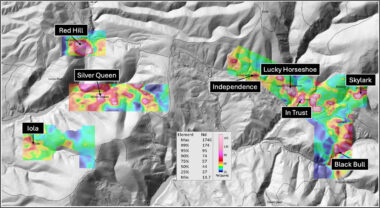The nation is on track to plant an impressive 23.48 million hectare winter crop this year – up slightly on last year’s crop area – Rabobank says in its newly-released 2023/24 Australian Winter Crop Outlook.
But while area under crop remains high – projected at approximately 0.3 per cent above last year and five per cent above the five-year average – overall harvest totals are forecast to be lower than last season, with expectations of drier growing conditions due to the likely transition to an El Nino climate cycle, the specialist agribusiness bank says.
“Australia’s harvest potential for the upcoming season is expected to be below the recent consecutive bumper harvests,” the report says. However, it could still be “a decent total”, keeping Australia “well positioned to support global wheat needs in 2023/24”.
Report co-author, Rabobank associate analyst Edward McGeoch said after three years of high rainfall and positive growing conditions in many cropping regions across Australia – which had resulted in a “streak of strong or record-breaking grains and oilseed production” – it was clear Australia was looking to lower harvest volumes in the year ahead with the move to drier seasonal conditions.
“On a national level, the season did not begin as well as in recent years, however April saw improved rainfall totals in several growing regions across New South Wales, Victoria and South Australia,” he said.
Plantings and production
Rabobank’s Australian Winter Crop Outlook forecasts planted area for wheat, barley and pulses to all be up for the season, but with canola planting down.
Wheat area is projected to increase 2.9 per cent on the previous year to 13.44 million hectares (11.5 per cent above the five-year average) with barley up 1.3 per cent to 4.27 million hectares (though still down 10.4 per cent on its five-year average). Area planted to pulses is also expected to increase on the previous year to 1.77 million hectares (though still down 8.4 per cent on the five-year average).
Canola planting is forecast to be down 8.4 per cent on last season to 3.32 million hectares. However, this would still be 21.2 per cent above the five-year average, Mr McGeoch said.
“Canola plantings have suffered as all other crops have benefited,” he said. “The trend in most states – including Western Australia, New South Wales and Victoria – is that canola planting is down on last year due to the pull back in prices and the drier start to the season which has seen farmers returning to cereal crops within their rotations.”
Assuming normal seasonal rainfall, Rabobank says, wheat production for 2023/24 could be expected to reach 29.9 million tonnes (down 24 per cent on the previous year), barley 10.8 million tonnes (down 24 per cent) and canola 5.4 million tonnes (a decline of 35 per cent).
However, Mr McGeoch said, with climate models indicating a transition to weak El Nino conditions, “we could see production drop lower, potentially to the lowest total crop in four years (at 41.2 million tonnes)”.
States
By state, crop plantings are expected to be up this year in Queensland, New South Wales and South Australia (by 3.5 per cent, 3.4 per cent and 0.3 per cent respectively). Western Australian planting is projected to be down 2.1 per cent and Victoria marginally by 0.2 per cent.
“For several areas across Queensland, early-season rainfall started relatively well, notably in the Fitzroy region, with above-average rainfall totals from January to April contributing to an expected jump in wheat planting,” Mr McGeoch said, “while in New South Wales, farmers are on track to plant a very large crop for the fourth consecutive year. Year-to-date rainfall in New South Wales has provided a full soil-moisture profile across the southern parts of the state.”
For South Australia, total plantings across the state are expected to remain relatively stable compared with last year, the report says, up just slightly to 3.8 million hectares.
Planted hectares in Western Australia, while down, remain slightly above the five-year average. Wheat plantings have also bucked the trend in the state, rising marginally.
“Lower soil-moisture profiles, due to lack of opening rainfall this year, have led to reduced plantings across the state, with little assistance provided for strong early crop establishment,” Mr McGeoch said. “The risk of a dry outlook is also a consideration given the autumn break was not as widespread as in recent strong seasons.”
For Victoria, overall crop plantings are expected to fall slightly from last year to 3.5 million hectares, Rabobank says, although various regions in the state are “showing increased area”.
Exports
Export opportunities for the upcoming winter crop remain positive for Australia’s key market in South-East Asia, the report says, with freight charges declining back to 2020 levels and with Australia’s position as a “favourable origin market”.
Assuming the development of “weak El Nino” in 2023, Rabobank’s base case forecast would have 15.7 million tonnes of wheat from the 2023/24 crop (not including carryover stock from the 2022/23 season) heading to export markets, with continued strong global demand for wheat. Australia’s exportable barley and canola surpluses from 2023/24 production would be expected to reach 3.3 million tonnes and 3.4 million tonnes respectively.
Market prices
In terms of global grain markets, Rabobank says recent price declines may reflect an only “temporary oversupply of crops in a complacent global market that is assuming nothing goes wrong later in the year”.
“Current global prices may be too complacent, given the political and seasonal risks around the world,” Mr McGeoch said. “In the short term, there is enough grain available on global markets. However, if we look even a little bit further, a myriad of potential issues are bubbling away. The obvious is the Black Sea grain corridor collapsing during Ukraine’s export season, but also Canada is becoming hot and dry, Argentina and the US remain dry and we now see Australia also becoming drier.”
Global wheat prices have collapsed 58 per cent from record levels seen in March 2022, the report says. However, Australian wheat prices have held up comparatively well, dropping just 20 per cent in the period, albeit from lower levels.
“Whether the local wheat prices continue to hold up well despite the global price decline depends on the outcome of local production,” Mr McGeoch said. “If Australian wheat production is more favourable than expected, basis could decline to negative levels.”
Globally, the bank forecasts Chicago Board of Trade (CBOT) wheat to trade on average between USc 624 and USc 683 a bushel over the next 12 months, but upside above this range could be possible.
Locally, Australian Premium White (APW1) wheat track prices are expected to trade, on average nationally, between AUD 340 and AUD 380 over the same period. How strong local prices remain will also be determined by whether drier conditions persist or not, Mr McGeoch said.
The fate of barley prices will partly hinge on the outcome of negotiations to lift Chinese tariffs, the report says. Pending this, for now, the bank forecasts Australian feed barley to continue trading at a heavier-than-average discount to wheat over the next 12 months, on average nationally between AUD 230 and AUD 270 track prices. The high premiums seen last year for malt barley should not be expected in the current season, the report says.
Rabobank forecasts Australian national non-GM (genetically-modified) canola prices to trade, on average, between AUD 560 and AUD 670 over the coming year, with GM canola trading at an AUD 20 to AUD 50 per tonne discount.
Crop inputs
On average, Australian farmers will increase fertiliser application this season, according to the bank’s research. This is the result of a decline in farm input prices after recent spikes, making fertiliser more affordable, Mr McGeoch said, as well as expectations of good returns from farming.
“Urea prices are expected to track around current levels, or with a minor increase, in the coming months,” he said.
Application of urea is projected to be up four per cent on last year, potash up three per cent and phosphate two per cent.
However, this would still be below the long-term average use of these fertilisers by Australian growers, Mr McGeoch said.
<ends>
Media contacts:
Denise Shaw Will Banks
Media Relations Media Relations
Rabobank Australia & New Zealand Rabobank Australia
Phone: 02 8115 2744 or 0439 603 525 Phone: 0418 216 103
Email: [email protected] Email: [email protected]
About us:
Rabobank Australia & New Zealand Group is a part of the international Rabobank Group, the world’s leading specialist in food and agribusiness banking. Rabobank has more than 120 years’ experience providing customised banking and finance solutions to businesses involved in all aspects of food and agribusiness. Rabobank is structured as a cooperative and operates in 38 countries, servicing the needs of more than nine million clients worldwide through a network of more than 1000 offices and branches. Rabobank Australia & New Zealand Group is one of Australasia’s leading agricultural lenders and a significant provider of business and corporate banking and financial services to the region’s food and agribusiness sector. The bank has 90 branches throughout Australia and New Zealand.



